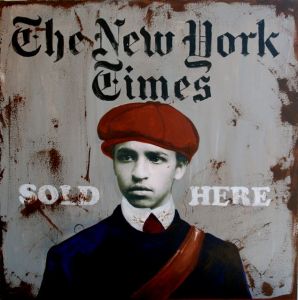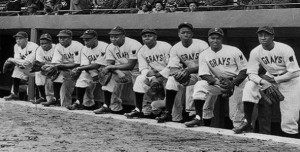Investment Aspects of Black History Collecting
Black History is Now an Industry and is Becoming a Big Business:
What African Americans have said, done, produced and been through is now the focus of an ownership explosion. An increasing number of people want to do more than just hear about it, read about it or argue about it – they want to own it and accumulate it. Like it or not, various types of Black history and culture is being sought after, bought, sold and collected on a scale that was unimaginable 10 years ago.
Prices for rare, original or interesting Black history and culture objects are rising rapidly. There is now such a thing as an investment grade object (i.e. one which will rise in market value and will provide a significant increase over the original purchase price). It should be noted that most Black history items are not investment grade but some are and some that are not today in that category will be in future years. Black history collectibles (discussed here) are different from so-called Black memorabilia collectibles which tend to focus on images of Blacks (usually perceived by others and often derogatory or stereotypical) rather than on what has actually happened to Blacks or what Blacks have produced or done. Black history items include books, documents and other ephemera, posters, autographs, photographs, artworks and three-dimensional artifacts (ranging from records, political buttons and Masonic medals to slave-made quilts and furnishings).

Despite exciting investment potential, Black history collectibles are a new type of investment and collecting for profit has definite risks. Like any investment, Black history items involve complexity, unpredictability and possible losses as well as gain and opportunity. The field has many uncertainties, pitfalls and swiftly changing market forces. Considerable knowledge, shrewd decision making and hard work is required to safely produce an adequate return. Unfortunately, there is little published information such as price history data to guide investors. This article expresses personal opinions and experiences and is intended to inform people about collecting trends and issues, but under no circumstances is it to be construed as investment advice.
Key Black History Collecting Trends
From both the collecting and investment point of view, a number of interesting trends and notable developments are occurring in Black history collecting.
COMMERCIAL USES OF BLACK HISTORY HAVE INCREASED TREMENDOUSLY: Advertisers, publishers, software makers, film makers, designers, and industries connected with sports and music, etc. have all become interested in Black history and seek to profit from its popularity. Commercial consumers of Black History, music, images, and objects find that they provide fresh arresting and absorbing experiences with considerable commercial usefulness.
MORE EMPHASIS ON ONE’S OWN BLACK HISTORY: More collectors are seeking Black history items that are closer to them in content, time frame, geography or personal significance. More and more people are becoming interested in their own Black history (their town or state, their occupation, their families, their schools) and not just the great national figures and topics. The rise of widespread interest, local history, and genealogy among African Americans is part of this trend.
MORE SPECIALIZATION AND DIVERSIFICATION: At its upper levels, the field has become more specialized and sophisticated. Rather than collect general Black history items, people now are specializing (in art, music, sports or military for example). Many collectors already have most of the general, common things and want different, more specialized material.
MANY COLLECTIONS ARE BEING SOUGHT, BOUGHT, SOLD OR SCRUTINIZED: Many major Black history and culture collections of books, documents, art and artifacts (some forgotten for many years) have been “rediscovered,” have changed hands, or become the subject of scrutiny or controversy. This has sometimes resulted in an outflow of valuable historical items from the Black community to those who can afford to acquire them.
THE RISE OF THE VISUAL:Many collectors now focus on visual and displayable objects (posters, prints, photos, etc.) rather than books and sometimes do not seem to read as much as they once did. Photographs, a major and very important collectible area is now all the rage and cuts across numerous specialty topics (e.g. sports, music, autographs, politics, etc.).
NEW COLLECTING SPECIALTIES AND THEMES CROP UP CONSTANTLY:Black history is a living, growing field that has changed over the years and will continue to change. New interests, themes, perspectives, and insights arise and exert an influence on collectors, scholars, dealers, and the public mind. Thus, perceptions change about what should be known, collected and considered important or valuable to own. Though some values and tendencies remain stable, new trends are cropping up all the time. Traditional aspects of Black history that will always be important, studied and collected include slavery, music and entertainment, and sports (where Blacks have been the focus or active participants for many years). Other areas have become well established within the past 30 years such as Black military history and Black art. Constant growth and change involves new collectors entering the field and sometimes even veterans who switch. Such collectors bring new energy, pursue new specialties and explore new themes.
Key Points to Remember When Collecting and Investing
Again, Investment in collectibles (or anything else) is fraught with the possibility of loss as well as gain. Thus, proceed with caution and at your own risk and don’t invest more than you can afford to lose and are willing to lose.
Know why you are buying and distinguish investment from hobby, esthetic or research buying (i.e. buying for fun, beauty, or information). It must be stressed clearly and firmly that no one can predict with certainty what is a good investment in terms of rising prices, and a lot depends on one’s circumstances (investment budget, ability to hold rather than cash in quickly, historical interests, etc. Think about whom is likely to buy items after you in order to gauge appreciation potential.
It is safer to invest in items that have wide, diverse markets (i.e. those items that have many potential buyers from several fields of interest).
Scarce, original, in-period, vintage items rather than new or common ones are likely to increase in value. Avoid recently manufactured, mass produced “collectibles of the future” that have little resale value. Old is usually better than new but original is definitely better than reproductions for investment purposes. Usually, only original, in period, authentic, vintage items in good condition with research value will have considerable resale value and investment potential.
In historical investing, items that have information content and tell a story are usually much more desirable than anonymous items that are difficult or impossible to research, explain or put into historical context. Items that can be described in terms of a specific time, place or person have more appeal than those that confront the next buyer with many unknowns.
Like the stock market, successful investing in Black history collectibles requires hard work and accumulated skill, not just luck. To recognize good buys and find undervalued material, one must research purchases, use reference books, study diligently and learn from knowledgeable people.
Deriving maximum profits from collectibles usually involves investing more than just the purchase price of an item. Beyond what is paid for an item, there are additional investments often required to reap a substantial gain such as the time needed to research the item’s historical significance and money for appraisal, insurance, conservation and marketing to potential buyers.
Buying and holding historical items for a period of months and years often leads to greater returns that a quick “flip” (i.e. selling for a quick profit soon after buying). Time is needed to research scarcity and historical value, locate the best buyers, and allow market demand to reach a peak.
To maximize long-term profit one must buy “ ahead of the market” and invest in things that are currently undervalued and not yet widely appreciated or fully priced.
It is often wiser to concentrate and specialize, buying a number of related items or accumulating a collection of similar items in a specialized field rather than buying miscellaneous, scattered, unrelated items. A “mishmash” of different types of items is not as attractive to specialist buyers willing to pay high prices as a collection that really says something about a given subject in detail with examples of different facets of the same theme.
Stay aware of and go to exhibits, books, films and other events that relate to one’s investments.
Collect books, exhibition catalogs, publicity materials and scholarly papers, etc. in your field.
In terms of selling, different buyers have different buying characteristics. Some buyers know more than others, some more than the seller. Some buyers may spend more but take longer and require much more red tape than others. Some demand more documentation (in terms of description and provenance) than others. Some (e.g. dealers or collectors) pay quicker but want bigger discounts.
New areas constantly emerge. Some traditional areas of Black history collecting and research will always retain value but newer, emerging areas – though more risky – might appreciate faster.
One’s goals and circumstances (e.g. ability to take risks or hold items over time ) as well as market conditions and opportunities will determine one’s collecting and investment strategy.<
Source: Elvin Montgomery, February 1, 2002
A specialist dealer in African American history materials. He acquires and makes available vintage, informative and collectible books, photographs, documents and other artifacts about the African American experience to libraries, museums, collectors, educators and researchers. Montgomery constantly monitors the market for African American history materials and is a close observer of new trends in the field — in popular, scholarly, collecting and investing arenas. It is his firm conviction that there is much yet to be done in exploring and explaining African American history and that many people, both African Americans and numerous others will benefit from the lessons that can be learned from it.






2 Comments
Great article.
Awesome